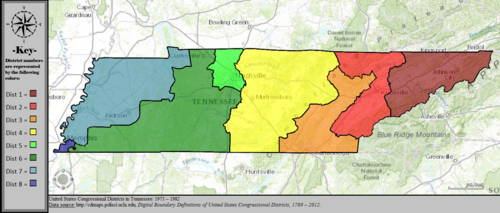Current districts and representatives
This is a list of United States representatives from Tennessee, their terms, their district boundaries, and the district political ratings according to the CPVI. The delegation has a total of nine members, with eight Republicans and one Democrat.
The Tennessee congressional maps are an example of partisan gerrymandering, in this case by the Republican-controlled state legislature, which in 2022 drew maps to ‘crack’ the Democratic stronghold of Nashville across three otherwise Republican districts, ensuring three Republican representatives, despite Nashville’s strong Democratic lean and population sufficient for a single district. [1] Critics claimed that this Republican gerrymander ‘diminished the influence of Black voters and other voters of color concentrated in Nashville’, by splitting them up and adding portions of the Nashville community into districts that are overwhelmingly white and Republican, thus diluting the voting power of Black voters in the state.’ However, in 2024 a federal court ruled that while the gerrymander is a clear ‘political gerrymander’ it didn’t fit the criteria for a ‘racial gerrymander.’ [2]
Historical and present district boundaries
Table of United States congressional district boundary maps in the State of Tennessee, presented chronologically. [5] All redistricting events that took place in Tennessee between 1973 and 2013 are shown.
| Year | Statewide map |
|---|
| 1973–1982 |  |
|---|
| 1983–1992 |  |
|---|
| 1993–2002 |  |
|---|
| 2003–2013 |  |
|---|
| 2013–2023 |  |
|---|
|
| Tennessee's 2nd congressional district |
|---|
Interactive map of district boundaries since January 3, 2023 |
| Representative | |
|---|
Due to three county island parcels near Sweetwater, Tennessee, Tennessee's 2nd congressional district is not geographically contiguous — rather it is politically contiguous, with county exclaves "connected" despite being entirely-surrounded by Tennessee's 3rd congressional district.
This page is based on this
Wikipedia article Text is available under the
CC BY-SA 4.0 license; additional terms may apply.
Images, videos and audio are available under their respective licenses.





























